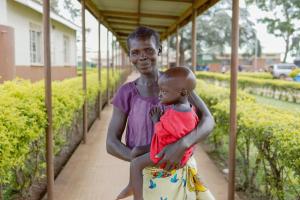Using Data to Tackle Acute Malnutrition in Uganda
In the West Nile region of Uganda, Dawa Zubeda, a mother of five, has been on a harrowing journey to improve her youngest son's health. Her story mirrors the struggle of many parents facing the harsh realities of severe malnutrition.
Zubeda’s journey to the health facility was fraught with uncertainty and fear. “When I took my son to the hospital, I thought he had malaria. He was weak, with a swollen body and no appetite,” she recalled.
It was a common misdiagnosis in a region where symptoms of severe malnutrition are often mistaken for other ailments. Zubeda’s son was diagnosed with acute malnutrition, a condition affecting over 268,000 children in Uganda according to the 2023 Joint Child Malnutrition Estimates by UNICEF, World Health Organization (WHO), and the World Bank.
To address this widespread health threat, Uganda launched a four-year Nutrition Information System (NIS) project in 2020. Funded by the European Union and jointly implemented by the Ministry of Health, WHO, and UNICEF, this project aims to enhance nutrition data management and improve decision-making in districts like Koboko, Yumbe, Kyegegwa, and Kamwenge.
“With support from our partners, we have trained and mentored over 500 health workers and 300 additional personnel to ensure effective nutrition data management,” explained Mr. Samalie Namukose, Assistant Commissioner in charge of Nutrition at Uganda’s Ministry of Health.
The NIS project, along with other key nutrition interventions, has made significant strides. Acute malnutrition (wasting) in children under five in Uganda decreased from 4% in 2016 to 2.9% in 2022, as reported by Uganda’s Demographic and Health Survey. The project has equipped healthcare workers with better tools and training for diagnosing and managing malnutrition.
“When malnutrition cases are detected and managed early, the chances of survival are higher,” noted Mr. Muzamil Chadribo, a Clinical Officer from Koboko District. Using WHO guidelines on the Integrated Management of Acute Malnutrition, health workers swiftly identified the nutritional problems in Zubeda’s child and provided specialized care, including therapeutic milk and supplements, alongside essential guidance to improve health and prevent infections.
After a week of treatment, Zubeda noticed significant improvements in her son’s health. “His swollen body has reduced, and there is no more diarrhea,” she recounted. Beyond physical recovery, Zubeda learned about proper nutrition and childcare from health workers, receiving invaluable advice on maintaining her child’s health and preventing future malnutrition.
Dr. Bodo Bongomin, WHO National Professional Officer in charge of Child Health and Nutrition, emphasized the importance of accurate and timely data in combating acute malnutrition. “To tackle the problem of acute malnutrition among children under five, accurate and timely data is essential to improve preventive efforts within communities as well as case management in health facilities,” he said. Immunization against diarrheal diseases also plays a crucial role in preventing malnutrition.
Zubeda’s journey highlights the critical impact of comprehensive nutrition programs and the power of data in transforming health outcomes. Her story is a testament to the progress being made in Uganda, one child at a time.
Communications Associate
WHO Uganda Country Office
Email: afwcougcom [at] who.int (afwcougcom[at]who[dot]int)
Phone: +256740487734
Communications Officer
WHO Uganda
Email: tcheutchouae [at] who.int (tcheutchouae[at]who[dot]int)
